Investing for Beginners: How Fed Rate Hikes Affect Your Portfolio

Investing for beginners can seem daunting, especially when the Federal Reserve raises interest rates; understanding how these hikes impact your investment portfolio is crucial for making informed decisions and navigating market fluctuations effectively.
Navigating the world of investing for beginners: understanding the impact of the Federal Reserve’s latest interest rate hike on your portfolio, can feel like traversing uncharted waters. However, grasping how Federal Reserve decisions affect your investments is a fundamental skill that empowers you to manage risk and optimize your returns.
Demystifying the Federal Reserve
The Federal Reserve, often called the Fed, plays a pivotal role in the U.S. economy. As the central bank, it’s responsible for maintaining economic stability and managing monetary policy. One of its key tools is adjusting the federal funds rate, which influences interest rates across the board.
What is the Federal Funds Rate?
The federal funds rate is the target rate that the Fed wants banks to charge one another for the overnight lending of reserves. This rate serves as a benchmark for other interest rates throughout the economy, impacting everything from mortgages to credit card rates.
How the Fed Influences the Economy
By raising or lowering the federal funds rate, the Fed can influence borrowing costs and overall economic activity. Higher rates tend to curb inflation by making borrowing more expensive, while lower rates stimulate growth by encouraging borrowing and spending.

- Controlling Inflation: The Fed raises rates to combat inflation by reducing the money supply and increasing the cost of borrowing.
- Stimulating Growth: Lowering rates encourages borrowing and investment, leading to economic expansion.
- Maintaining Stability: The Fed aims to keep the economy on an even keel, avoiding both runaway inflation and deep recessions.
Understanding the Fed’s role is the first step in comprehending how its decisions impact your investment portfolio. Stay tuned as we delve deeper into the specifics of interest rate hikes.
Understanding Interest Rate Hikes
When the Federal Reserve announces an interest rate hike, it sends ripples throughout the financial markets. It’s essential to understand what this means and how it can affect various aspects of your investments.
The Mechanics of Rate Hikes
An interest rate hike means the Fed is increasing the federal funds rate. This, in turn, leads to higher borrowing costs for banks, which they then pass on to consumers and businesses through higher interest rates on loans, mortgages, and credit cards.
Why the Fed Hikes Rates
The primary reason the Fed hikes interest rates is to combat inflation. When the economy is growing too quickly, and prices are rising rapidly, the Fed uses rate hikes to cool things down. By making borrowing more expensive, it reduces consumer spending and business investment, which can help bring inflation under control.
- Cooling Down the Economy: Higher rates reduce spending and investment, slowing down economic growth.
- Controlling Inflation: Increased borrowing costs help to curb rising prices.
- Attracting Investors: Higher rates can make U.S. assets more attractive to international investors, strengthening the dollar.
The impact of interest rate hikes can be felt across different asset classes, from stocks and bonds to real estate. Let’s explore these impacts in more detail in the following sections.
Impact on Stock Investments
The stock market, being forward-looking, can react strongly to Federal Reserve interest rate decisions. Understanding how these hikes can influence stock values is crucial for beginner investors.
Short-Term Market Reactions
Initially, stock markets often react negatively to news of a rate hike. This is because higher interest rates can lead to increased borrowing costs for companies, potentially reducing their profitability. Investors may sell off stocks in anticipation of lower earnings.
Long-Term Effects
Over the long term, the impact on stocks can be more nuanced. If the rate hike successfully curbs inflation without significantly slowing economic growth, the stock market can recover and even thrive. However, if the rate hikes lead to a recession, stocks are likely to suffer.

- Growth Stocks: Companies that rely heavily on borrowing for expansion may see their growth prospects dimmed.
- Value Stocks: Companies with strong balance sheets and consistent earnings may be more resilient.
- Dividend Stocks: Higher interest rates can make dividend stocks more attractive to income-seeking investors.
It’s important for investors to consider their investment horizon and risk tolerance when assessing the impact of rate hikes on their stock portfolio. Diversification can play a key role in mitigating potential losses.
Navigating Bond Investments After Rate Hikes
Bonds are particularly sensitive to interest rate changes. Understanding how rate hikes affect bond values is essential for anyone with fixed-income investments.
Bond Prices and Interest Rates
Bond prices and interest rates have an inverse relationship. When interest rates rise, the value of existing bonds typically falls. This is because newly issued bonds will offer higher yields, making older, lower-yielding bonds less attractive.
Strategies for Bond Investors
Beginner investors can employ several strategies to navigate the bond market after a rate hike. One option is to shorten the duration of their bond portfolio, reducing its sensitivity to interest rate changes. Another strategy is to consider investing in floating-rate bonds, which adjust their interest payments based on prevailing rates.
- Shortening Duration: Investing in bonds with shorter maturities reduces interest rate risk.
- Floating-Rate Bonds: These bonds offer interest payments that adjust with market rates.
- Diversification: Spreading investments across different types of bonds can help mitigate risk.
Bond investments can still play a valuable role in a diversified portfolio, even in a rising-rate environment. The key is to understand the risks and adjust your strategy accordingly.
Diversification and Risk Management
Diversification and effective risk management are essential strategies for beginner investors, particularly when navigating the uncertainties of interest rate hikes.
The Power of Diversification
Diversification involves spreading your investments across different asset classes, sectors, and geographic regions. By diversifying, you reduce the risk of significant losses if one particular investment performs poorly. During times of interest rate volatility, a well-diversified portfolio can provide more stability and potential for long-term growth.
Strategies for Mitigating Risk
In addition to diversification, consider adopting a risk management strategy that aligns with your investment goals and risk tolerance. This might involve setting stop-loss orders, rebalancing your portfolio regularly, or consulting with a financial advisor.
- Asset Allocation: Determine the appropriate mix of stocks, bonds, and other assets based on your risk tolerance and investment goals.
- Regular Rebalancing: Periodically adjust your portfolio to maintain your desired asset allocation.
- Stop-Loss Orders: Set automatic sell orders to limit potential losses on individual investments.
Remember, investing involves risk, and there are no guarantees. However, by taking a disciplined approach to diversification and risk management, you can increase your chances of achieving your long-term financial goals, even as interest rates fluctuate.
Long-Term Investment Strategies
Despite the short-term market fluctuations that may occur due to interest rate hikes, beginner investors should focus on developing and maintaining long-term investment strategies.
Staying the Course
One of the most important things investors can do is to avoid making impulsive decisions based on short-term market movements. Trying to time the market is notoriously difficult, and it often leads to missed opportunities and costly mistakes. Instead, focus on your long-term goals and stick to your investment plan.
Dollar-Cost Averaging
Dollar-cost averaging is a strategy that involves investing a fixed amount of money at regular intervals, regardless of market conditions. This approach can help reduce the risk of buying high and selling low, as you’ll be purchasing more shares when prices are lower and fewer shares when prices are higher.
- Focus on Fundamentals: Invest in companies with strong financial fundamentals and a history of consistent earnings growth.
- Reinvest Dividends: Reinvesting dividends can boost your long-term returns.
- Monitor Your Portfolio: Regularly review your portfolio to ensure it still aligns with your investment goals and risk tolerance.
By adopting a long-term perspective and following a disciplined investment approach, beginners can navigate the uncertainties of interest rate hikes and build a solid foundation for their financial future.
| Key Point | Brief Description |
|---|---|
| 📈 Interest Rate Hikes | The Federal Reserve increases the federal funds rate to manage inflation and economic growth. |
| 📉 Impact on Stocks | Higher rates can initially cause market downturns but long-term effects depend on economic stability. |
| 💰 Bond Strategies | Consider short-term or floating-rate bonds to navigate rising rates. |
| 🛡️ Diversification | Diversify across asset classes to mitigate risks associated with market volatility. |
FAQ
▼
The Federal Reserve, the central bank of the U.S., manages monetary policy to ensure economic stability, controls inflation, and promotes full employment.
▼
Initially, stocks may decline due to increased borrowing costs. However, long-term effects depend on controlling inflation without causing a recession.
▼
Consider shortening bond durations or investing in floating-rate bonds. Diversification across different bond types helps in a rising rate environment.
▼
Diversification spreads investments across various assets, reducing the risk of significant losses from poor performance in any single investment.
▼
Adopt dollar-cost averaging by investing a fixed amount regularly, regardless of market conditions, to reduce the risk of buying high and selling low.
Conclusion
Understanding the impact of Federal Reserve interest rate hikes is crucial for beginner investors. By grasping the role of the Fed, exploring the effects on stocks and bonds, and implementing diversification and long-term strategies, you can navigate market fluctuations and build a resilient investment portfolio.